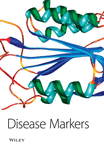Quasimonomorphic Mononucleotide Repeats for High-Level Microsatellite Instability Analysis
Abstract
Microsatellite instability (MSI) analysis is becoming more and more important to detect sporadic primary tumors of the MSI phenotype as well as in helping to determine Hereditary Non-Polyposis Colorectal Cancer (HNPCC) cases. After some years of conflicting data due to the absence of consensus markers for the MSI phenotype, a meeting held in Bethesda to clarify the situation proposed a set of 5 microsatellites (2 mononucleotide repeats and 3 dinucleotide repeats) to determine MSI tumors. A second Bethesda consensus meeting was held at the end of 2002. It was discussed here that the 1998 microsatellite panel could underestimate high-level MSI tumors and overestimate low-level MSI tumors. Amongst the suggested changes was the exclusive use of mononucleotide repeats in place of dinucleotide repeats. We have already proposed a pentaplex MSI screening test comprising 5 quasimonomorphic mononucleotide repeats. This article compares the advantages of mono or dinucleotide repeats in determining microsatellite instability.




